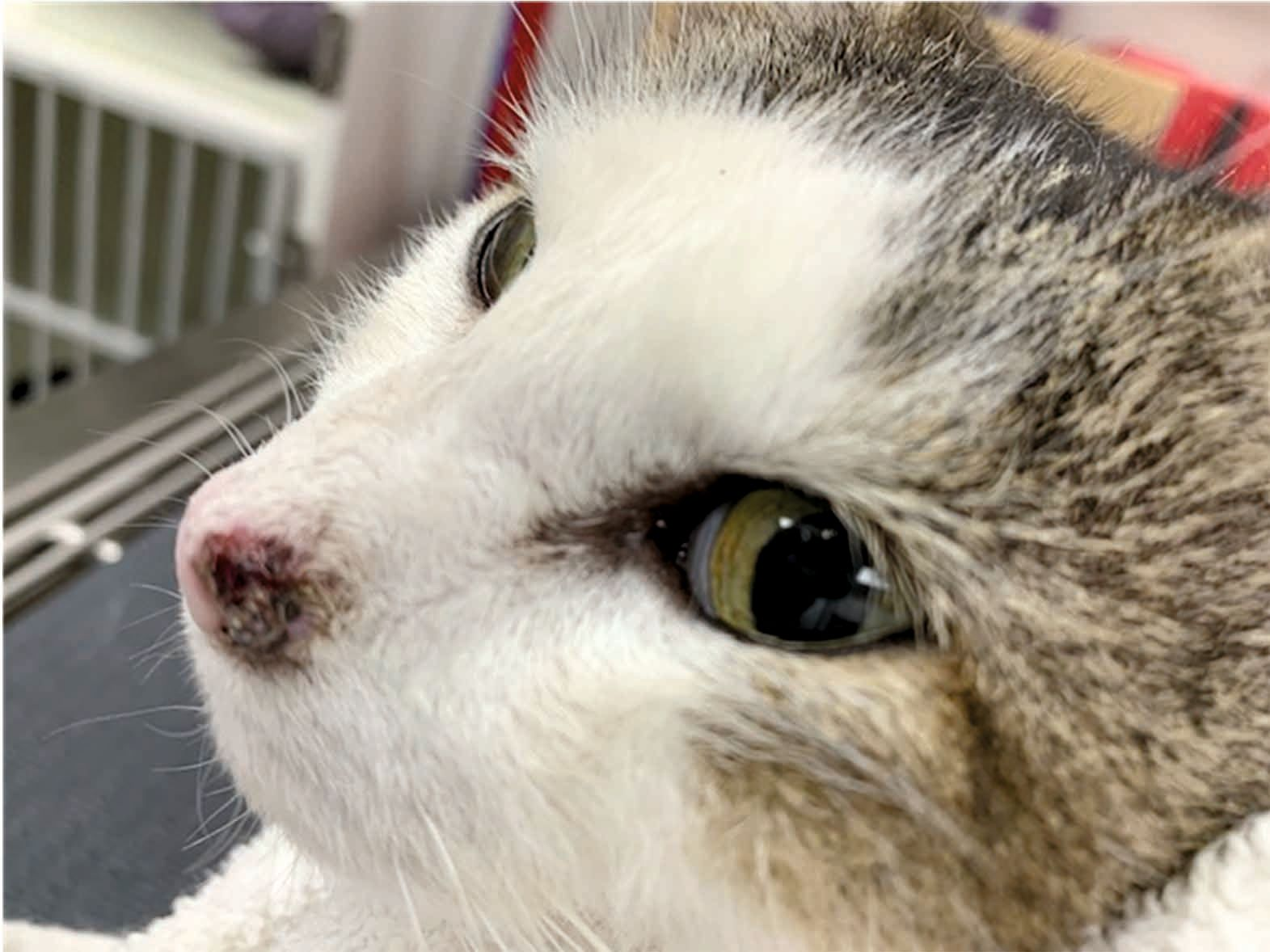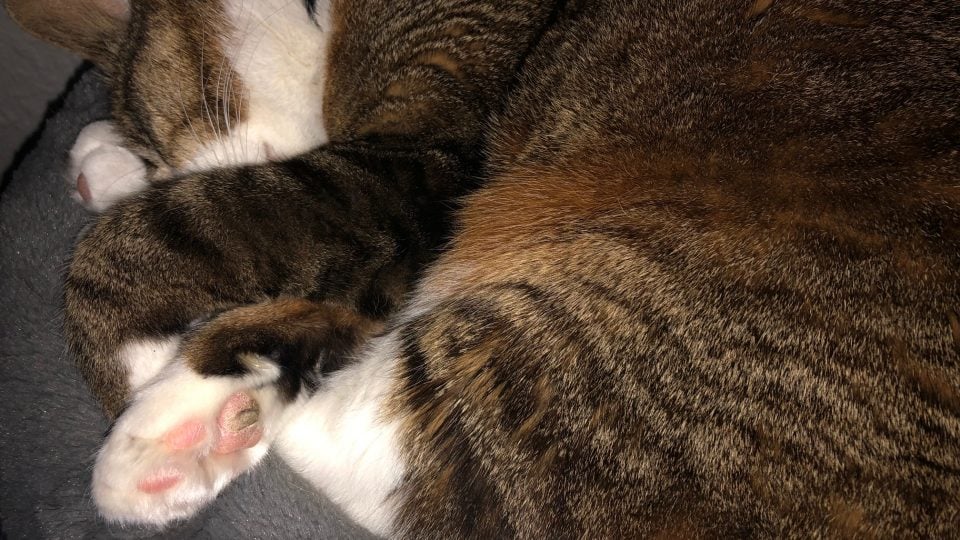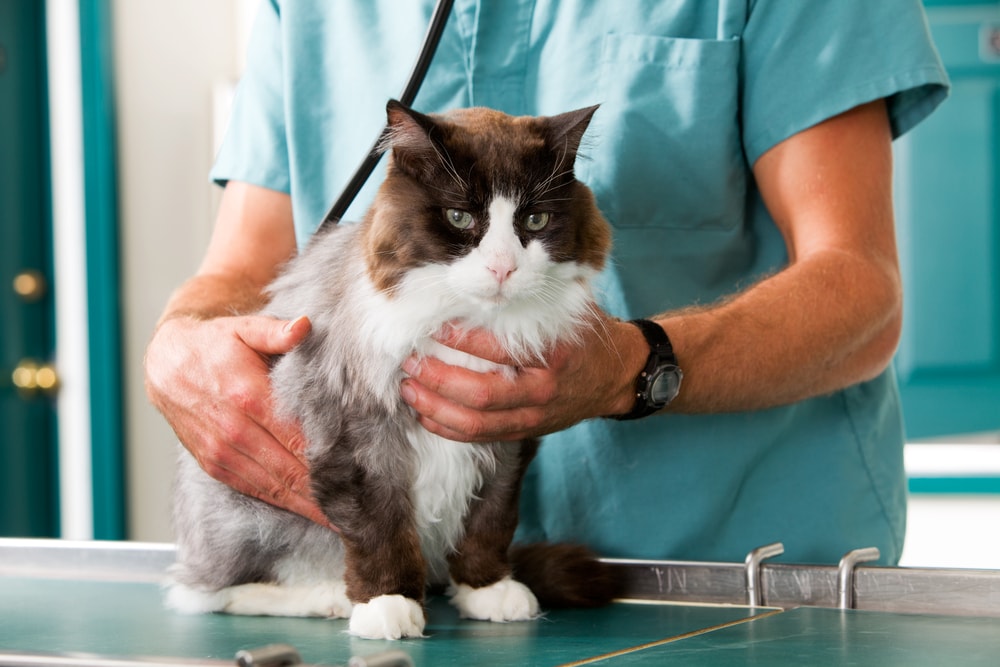sarcoma in cats foot
These tumors generally appear as firm solitary often hairless or ulcerated lumps. They vary in size from less than 04 inches 1 centimeter to more than 4 inches 10 centimeters in diameter.
Skin tumors are some of the most commonly identified tumors in cats primarily because the skin is particularly susceptible.

. A rare type of cancer called feline lung-digit syndrome may also cause tumors to appear on the toes or feet. Nerve sheath tumor previously called neurofibrosarcoma schwannoma hemangiopericytoma Rhabdomyosarcoma. If the tumor can be removed the cats leg mayreturn to normal.
Sarcomas affecting various body tissues have always been seen in cats but since the early 1990s the occurrence of sarcomas at sites commonly used for vaccination such as the shoulder lumbar region lower back flank side of body and upper hind leg led researchers to see if there was a direct association with vaccination. The most common injection-site sarcoma in cats is a fibrosarcoma. The SCC does not retain its appearance as a solid mass.
Limping or not wanting to move around. He told me me due to the size of the tumor and because it was entwined with all the sinews and. Swollen toes or feet.
The most common cell type affected is the fibroblast giving the tumor the name fibrosarcoma. This tumor deserves extra attention and study for several reasons. Symptoms of sarcoma in the foot and ankle vary.
An injection-site sarcoma is a tumor of the connective tissues in the cat. The vet told us there were no visible metastases. It has a low to moderate chance of spreading.
There are two major root causes. What You Can Do. Synovial sarcoma is the most common malignant soft tissue sarcoma in the foot accounting for 18-22 of all such tumors.
He told me the cancer was synovial sarcoma an extremely rare form of cancer. A summary of this information is. While this form of cancer can affect any breed of cat it remains a rare type of foot cancer in cats.
Connective muscle and nervous tissues are present. Connective muscle and nervous tissues are present throughout the entire body. The tumor types behave similarly and are therefore treated the same.
Several types of skin cancer can affect the toes as well. Symptoms of a Synovial Sarcoma. Peripheral nerve sheath tumor.
Another treatment option is chemotherapy. Risk of malignant tumor metastasis. Other tumor types have been described osteosarcoma chondrosarcoma malignant fibrous histiocytoma.
3 Where possible surgical removal is the best option. Feline sarcoma virus FeSV is a rare hybrid virus that causes an extremely fast growing type of fibrosarcoma. The single fascial plane achieved a.
Nerve sheath tumor previously called neurofibrosarcoma schwannoma hemangiopericytoma Rhabdomyosarcoma. The tumor in my foot was 12cm x 5cm which was a fair rotten beast in my size 8 foot. What are soft tissue sarcomas.
The term soft-tissue sarcoma encompasses a broad category of tumors that show up in a cats connective muscle or nervous tissues. Lumps are quite common on older dogs and not all lumps are cancerous. Most soft tissue sarcomas are solitary tumors in middle to older aged pets and tend to be over-represented in large breed dogs.
These tumors are the result of abnormal production of these cell types in an uncontrolled manner. These rare types of fibrosarcomas typically grow very fast. Therefore these tumors can develop over the chest.
Surgery was performed 2 weeks after the diagnosis. The lumps may stick out like stalks from the skin surface. My wonderful doctor sat my husband and me down and told us the seriousness of it.
Lesions with or without pigment Enlarged lymph nodes Difficulty breathing Lung cancer Limping if spread to limbs. Soft tissue sarcomas are a broad category of tumors including those that arise from the connective muscle or nervous tissues in dogs or cats. These include soft tissue sarcoma fibrosarcoma and squamous cell carcinoma.
Symptoms of this condition include. Anatomically these tumors arise from mesenchymal cells the precursors of bone cartilage and other connective tissues. 1 hemangiosarcoma is much less common in cats than in dogs 2 hemangiosarcoma in cats arise about 50 of the time in the abdominal organs and about 50 of the time in subcutaneous tissues.
A study on feline vaccine-associated sarcomas in cats following excision with 3 cm wide margins and one facial plane deep showed that 1 cm away from palpable tumor the tissue was free of neoplasia in 13 cases by 2 cm from the mass 32 were free of cancer cells and by 3 cm 94 were free of neoplasia. In some cases the sarcoma is a visible lump and can look much like a benign ganglion cyst. Fibrous Fibroid Sarcoma In Cats - Fibrous or fibroid Sarcoma In cats is cancer that develops in the fibroblast cells the most abundant cell in cat connective tissue.
9 In some series it is the single most common sarcoma of any type in the distal lower extremity. Soft tissue sarcomas or STSs are a group of cancers that arise from skin and subcutaneous tissues. Soft Tissue Sarcoma in Dogs What is a soft tissue sarcoma.
In cats these tumors are often dark in color. These tissues represent 15 of all skin tumors and 7 of all subcutaneous tumors in cats and dogs. Common STSs in cats and dogs are.
Feline sarcoma virus. Chemotherapy consists of four to six treatments given at three-week intervals. It is usually chosen to treat tumors with a higher likelihood of metastasis but can also be used as an effective method to target cancer cells in cats with vaccine-associated sarcomas.
Soft tissue sarcomas are a group of malignant cancers that arise from the skin and subcutaneous connective tissues such as fat muscle cartilage fibrous connective tissue nerves and. My 9 year old cat was diagnosed with sarcoma 2 months ago. What Are the Symptoms Of Sarcoma Cancer In Dogs.
Over time it will grow the tissue within the mass will die necrotize and the tumor will ulcerate. According to research this virus only occurs in 2 percent of cats and they are typically young ones that have also contracted Feline Leukemia Virus FeLV. Some sarcomas cause no pain while others are painful right from the outset.
A large tumor was removed attached to and blocking jejunum pathology report stated that the excision was complete and the anastomosed ends were clean. The mass may have been slowly growing for months years or even decades.

Cat 6 Squamous Cell Carcinoma On Nose Stage T2 One Ect Session Download Scientific Diagram

Learn About Soft Tissue Sarcomas In Cats Petcure Oncology

A 12 Year Old Female Spayed Cat With Palpebral Carcinoma Patient At Download Scientific Diagram

Coping With Cat Cancer Symptoms And Advice Blue Cross

Pin On Animals For The Love Of

Vet Focus 31 1 Diseases Of The Feline Nasal Planum Vet

Foot Or Toe Cancer In Cats Symptoms Causes Diagnosis Treatment Recovery Management Cost

Understanding Lymphoma In Cats
How To Help Your Cat Fight Cancer Naturally Homeoanimal Com

Signs Of Cancer In Cats How To Tell If Your Cat Has Cancer Daily Paws

Cat 8 Squamous Cell Carcinoma With Infiltrative Growth Into Nasal And Download Scientific Diagram

Cat Horned Paws What Is That Thing Growing On My Cat S Paw

Mast Cell Tumors In Your Cats Kittens Venetian Pet Hospital

Learn About Osteosarcoma Bone Cancer In Cats Petcure Oncology

Pin By 𝐒𝐨𝐟𝐢𝐚 𝐑𝐚𝐦𝐨𝐬 On Aesthetics N Vibes N Gifs Animals Cats Vibes

Feline Fibrosarcoma Bluepearl Pet Hospital

Mast Cell Tumors In Cats Symptoms Causes Treatments Cattime Cats Cat Symptoms Cat Facts


